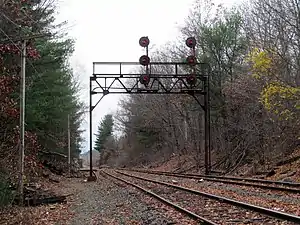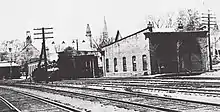Stony Brook Railroad
The Stony Brook Railroad, chartered in 1845, is a railroad company which constructed a rail line between the Nashua and Lowell Railroad's main line at the village of North Chelmsford and the town of Ayer, Massachusetts (then the village of South Groton) where it connected to the Fitchburg Railroad. Rather than running its own trains, upon opening in 1848 operations were contracted to the Nashua and Lowell; this arrangement continued until that company was leased by the Boston and Lowell Railroad in 1880. Operation of the Stony Brook Railroad in turn passed to the Boston and Maine Railroad in 1887, which became Guilford Rail System (today known as Pan Am Railways) in 1983. Passenger service last ran on the line in 1961, but it sees significant freight service under Pan Am Railways.
 A signal bridge on the former Stony Brook Railroad in Graniteville | |
| Overview | |
|---|---|
| Current operator | Pan Am Railways |
| Dates of operation | 1848– |
| Technical | |
| Track gauge | 4 ft 8+1⁄2 in (1,435 mm) standard gauge |
| Length | 10.8 miles (17.4 km) |
The Stony Brook Railroad was named after Stony Brook, which follows the line for several miles before joining the Merrimack River.
History
Formation, construction, and Nashua and Lowell operations
The Stony Brook Railroad was chartered in 1845 by citizens of Lowell to connect the city with points south and west.[1] Construction was completed in 1848. A few months before the new line opened, the Stony Brook owners entered into an agreement with the Nashua and Lowell Railroad (N&L), which connected to the line at its eastern terminus in North Chelmsford, to operate train service on the line. The SBR never owned its own rolling stock, so the line became an intricate part of the N&L, which from 1857 to 1868 operated jointly with the Boston and Lowell under the unofficial name of the Boston, Lowell and Nashua Railroad.[1]
During its early years, the Stony Brook line was not very profitable for the N&L, but the company kept the line open to keep it out of the hands of it rivals, the Fitchburg RR.
One unusual source of traffic on the Stony Brook Railroad was ice, which was cut from several ponds adjacent to the right of way and shipped to customers via the railroad.[2]
In 1877, the B&L and N&L decided to terminate their joint operating agreement, and the line reverted to sole control and operation by the Nashua and Lowell Railroad.[1]
Boston and Lowell and Boston and Maine operations
Following the breakup of the joint Nashua and Lowell and Boston and Lowell operating agreement, the Boston and Lowell leased its former partner in 1880, becoming the operator of the Stony Brook Railroad as well.[1]
The Boston and Maine Railroad (B&M) leased the Boston and Lowell in 1887, also gaining control of the Stony Brook Railroad. Under the B&M, the line grew in importance as a route for traffic between Maine and the rest of the country which bypassed the busy city of Boston.[1]
By 1911, freight and some passenger trains that used the Worcester and Nashua line were rerouted over the Stony Brook. In 1928, the line was double tracked to handle the increase in traffic. A western wye was installed at North Chelmsford so that all trains between Nashua and Ayer could use this line.
In 1946, the B&M decided to relocate the connection of the Stony Brook and Fitchburg lines two miles east of Ayer Station to eliminate the parallel running of the two tracks. The Stony Brook track from the Willows section of Ayer to Ayer Junction were abandoned, and a new connection with the Fitchburg line was made at Willows Station. In 1957, the second track was taken up from Willows to Graniteville and from Westford to North Chelmsford.
Today, the Stony Brook line is still operating as part of the main freight line for Pan Am Railways through Massachusetts. With trains coming through from Maine and the Nashua, New Hampshire, area every day, it is the busiest part of the old Guilford line in the state. The Stony Brook Railroad Corporation nominally still exists as a paper railroad as of 2021, under 99.27 percent ownership by the Boston and Maine, which is in turn owned by Pan Am Railways.[3]
Buffalo Bill derailment
On May 24, 1911, a circus train carrying Buffalo Bill's Wild West show derailed on the Stony Brook Railroad near Brookside. The accident, described by The Boston Globe as "one of the most spectacular in the history of railroading in this section," was later reported to have been caused by a ramp for loading and unloading elephants.[4][5] This ramp was not securely fastened and became loose while the train travelled, hitting an assortment of lineside objects until finally hitting a switch stand in Brookside, derailing the train.[5] While no humans were killed, two unfortunate burros were crushed to death by an elephant which fell on them when the train derailed, and three members of the Wild West show were seriously injured.[4] Members of the show, with the assistance of a Boston and Maine Railroad wrecking crew, gradually freed the trapped men and animals from the derailed cars, and the Wild West show proceeded to Lowell by road instead.[4]
Stations

| Town | Milepost | Station | Location | Notes |
|---|---|---|---|---|
| Chelmsford | 0.00 | North Chelmsford | Connection to Boston and Lowell Railroad | |
| 2.06 | West Chelmsford | |||
| Westford | 2.76 | Brookside | ||
| 4.28 | Westford | |||
| 6.11 | Graniteville | |||
| 7.38 | Forge Village | |||
| Littleton | 8.96 | North Littleton | ||
| Ayer | 10.66 | Willows | Formally named Sandy Pond[5] | |
| 13.19 | Ayer Junction | Connection to Fitchburg Railroad | ||
| Source[6] | ||||
References
- Karr, Ronald Dale (2017). The Rail Lines of Southern New England (2nd ed.). Pepperell, Massachusetts: Branch Line Press. pp. 260–262. ISBN 978-0-942147-12-4.
- "Ice From The North". Boston Evening Transcript. 1876-03-24. p. 1. Retrieved 2022-03-13.
- "CSX Corporation and CSX Transportation, Inc., et al.-Control and Merger-Pan Am Systems, Inc., Pan Am Railways, Inc., Boston and Maine Corporation, Maine Central Railroad Company, Northern Railroad, Pan Am Southern LLC, Portland Terminal Company, Springfield Terminal Railway Company, Stony Brook Railroad Company, and Vermont & Massachusetts Railroad Company". Federal Register. July 30, 2021. Retrieved April 17, 2022.
- "Buffalo Bill's Train Wreck". The Boston Globe. 1911-05-24. p. 1. Retrieved 2022-03-14.
- Wilder, H. Arnold (1979). The Stony Brook Railroad (PDF).
- "Stony Brook Branch Stations". www.nashuacitystation.org. Retrieved 2020-07-14.
Further reading
- Karr, Ronald D. (1994). Lost Railroads New England. Branch Line Press. ISBN 0-942147-04-9.